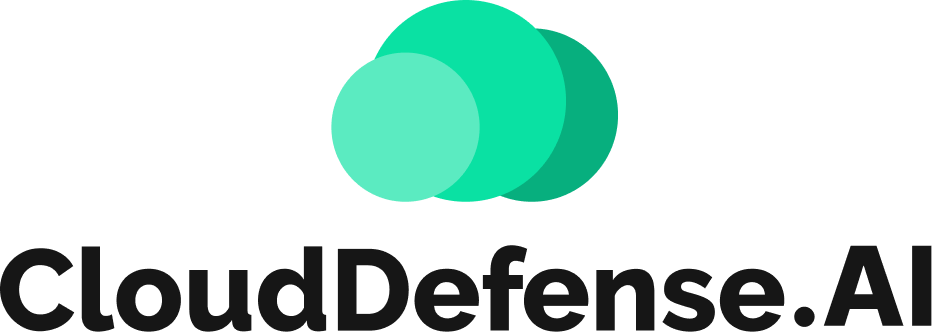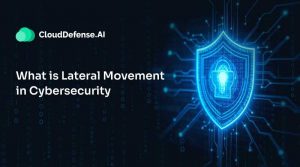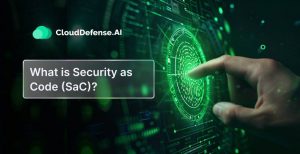What is a SOC framework?
So what exactly is this SOC framework we’re talking about? Simply put, it’s a comprehensive set of guidelines and best practices for running an effective Security Operations Center.
Think of it like an instruction manual for your SOC – a step-by-step guide that walks you through all the key components needed to get your cyber defense command center up and running like a well-oiled machine.
The framework covers all the bases, from the nitty-gritty technical details to the big-picture strategy. It lays out how to structure your SOC team, what tools and technologies to use, processes for detecting and responding to threats, metrics to measure performance, and more.
At its core, a SOC framework acts as a standardized set of guidelines that define how a SOC should approach its core functions. These functions typically include:
- Threat intelligence: Gathering information about potential threats and attacker tactics.
- Security monitoring: Continuously tracking activity across IT systems for suspicious behavior.
- Incident management: Having a structured process for identifying, investigating, and resolving security incidents.
And, a SOC team typically involves security professionals with expertise in:
- Security Analysts: Monitoring security systems, investigating alerts, and identifying threats.
- Security Engineers: Maintaining and optimizing security tools and infrastructure.
- Security Managers: Overseeing SOC operations, leading incident response, and strategizing security posture.
Key Components of a SOC Framework
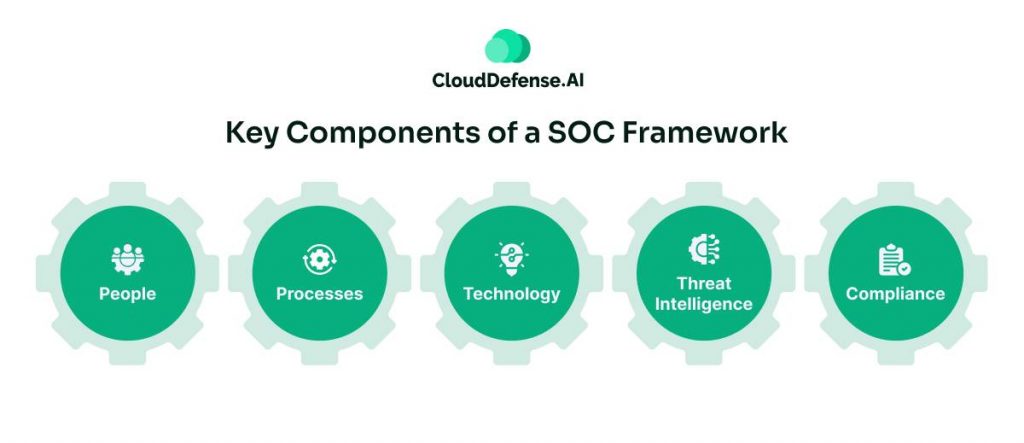
A strong SOC framework relies on several crucial building blocks, working together to create a robust cybersecurity defense. Here are the essential components. These five components – People, Processes, Technology, Threat Intelligence, and Compliance – are the fundamental building blocks of a strong SOC framework. They represent the who, what, why, and how of a well-functioning SOC.
- People: The human element is vital. Security analysts, engineers, and incident responders with expertise are the backbone of any SOC.
- Processes: Defined procedures guide every step of the SOC’s operation. This includes protocols for threat hunting, incident response, and ongoing improvement.
- Technology: A suite of security tools empowers the SOC team. Security Information and Event Management (SIEM) systems, intrusion detection systems (IDS), and threat intelligence feeds are just a few examples.
- Threat Intelligence: Continuous awareness of the latest threats and attacker methods is crucial. The SOC framework should incorporate strategies for gathering and utilizing threat intelligence.
- Compliance: Regulations and industry standards often dictate specific security controls. The SOC framework should ensure the organization adheres to these compliance requirements.
Core Functions of a SOC Framework
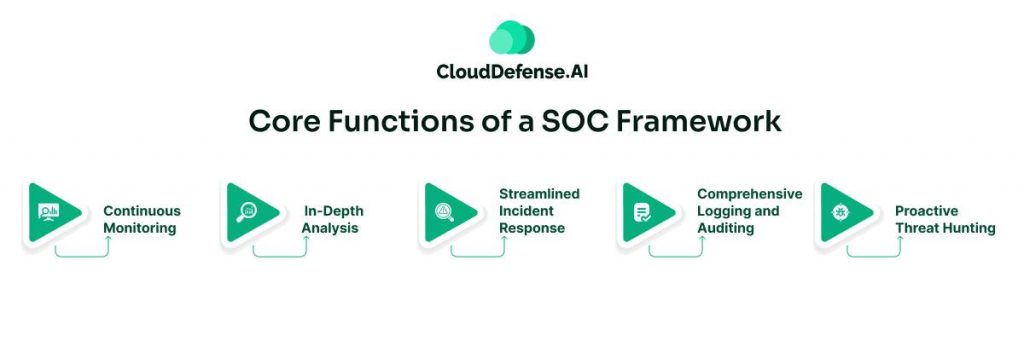
While the key components provide the building blocks, the true power of a SOC framework lies in its core functions. These functions define the specific activities a SOC team undertakes to achieve optimal security posture. Here’s a breakdown of some essential functions:
1. Continuous Monitoring
Just like a watchful guardian, a SOC needs to be vigilant around the clock. The framework ensures the implementation of tools like SIEM and XDR to collect and analyze security data from various sources. This enables the SOC team to spot suspicious activity and potential threats proactively.
2. In-Depth Analysis
A barrage of alerts and data can overwhelm even the most skilled analyst. The SOC framework promotes the use of AI and machine learning to sift through this data. These technologies help differentiate real threats from false positives, allowing analysts to focus their expertise on the most critical issues.
3. Streamlined Incident Response
When a threat is identified, swift and decisive action is crucial. The framework incorporates incident response protocols, ensuring a well-coordinated effort. Security tools like XDR, EDR, and SOAR can further streamline this process by automating certain actions and providing support for remediation efforts.
4. Comprehensive Logging and Auditing
Maintaining a detailed record of security events is essential. The framework emphasizes robust logging practices to document security incidents and responses. Additionally, SOAR solutions can automate log generation for regulatory compliance and internal reporting purposes.
5. Proactive Threat Hunting
Cybercriminals are constantly evolving their tactics. The SOC framework acknowledges this by emphasizing proactive threat hunting. This involves using security tools to actively search for hidden threats within the organization’s systems, ensuring no attacker goes undetected.
Exploring Different Types of SOC Services
The SOC framework provides a foundation for robust cybersecurity, but organizations have varying needs and resources. To cater to this diversity, different SOC service models have emerged. Let’s explore some of the most common options:
Dedicated SOC
For organizations with high-security needs and the resources to invest, a dedicated SOC offers the ultimate level of control. An in-house SOC is a team of security professionals physically located within the organization, managing all aspects of security operations and providing a tailored defense strategy.
Security Operations Center as a Service (SOCaaS)
For organizations lacking the resources for an in-house SOC, SOCaaS offers a compelling solution. Security providers remotely monitor and manage your security infrastructure, delivering threat detection, analysis, and response capabilities.
Co-managed SOC
This approach combines internal security expertise with the resources of a managed security service provider (MSSP). The organization retains control over specific SOC functions, while the MSSP supplements their capabilities with staff, expertise, and technology.
Command SOC
This centralized SOC model is often used by large enterprises with geographically dispersed operations. It acts as a central hub, coordinating the activities of multiple regional or subsidiary SOCs, ensuring a unified security posture across the organization.
Choosing the right SOC service model depends on your specific needs, budget, and security maturity. Understanding these options empowers you to select the model that best aligns with your organization’s unique cybersecurity requirements.
Challenges and Solutions for Implementing a SOC Framework
While the SOC framework offers a roadmap for robust cybersecurity, its implementation isn’t without hurdles. Here’s a look at some common challenges organizations face:
Resource Constraints — Building a kickass SOC team takes major investment, both in personnel and tech. Finding and keeping top-tier security analysts ain’t easy, especially for smaller organizations working with limited budgets and resources.
Alert Fatigue — Modern security systems pump out alerts like crazy, creating a firehose of data that can straight-up overwhelm your analysts. This “alert fatigue” increases the risk of potentially missing critical threats amidst all the noise.
Data Overload — Speaking of data, effectively managing and making sense of the sheer vastness of security data collected is its own challenge.
Integration Issues — With various security tools coming from different vendors, getting them all to properly sync up and talk to each other can be a headache. A fragmented, disconnected security stack hinders info-sharing within the SOC.
Compliance Complexity — Keeping up with the ever-changing web of compliance regulations and requirements is a full-time job in itself for SOC teams. As if defending against threats wasn’t enough!
Fortunately, solutions exist to address these challenges:
Make use of Managed Security Services (MSSPs) — For organizations struggling with staffing and skills gaps, partnering with a managed security services provider (MSSP) can be a game-changer. These third-party contractors provide access to seasoned security talent when and where you need it.
Prioritization and Automation — Implementing smart tools and processes for prioritizing high-risk alerts over the noise, while automating routine tasks, frees up analysts to focus on the truly gnarly threats. It’s like a cyber triage system.
Data Lake Solutions — Utilizing data lake solutions can help manage and analyze large volumes of security data effectively.
Standardization and Consolidation — Standardizing security tools across the organization can simplify integration and streamline data flow within the SOC.
Compliance Management Tools — Utilizing compliance management tools can automate tasks and streamline the process of adhering to relevant regulations.
A Guide to Creating a Strong SOC with Effective Tools and Solutions
Nowadays, cyber threats are a constant threat. To strengthen your defenses, a SOC equipped with the right tools and solutions is a powerful weapon in your arsenal. But how do you build a strong SOC that effectively safeguards your organization? Here’s a roadmap to guide you:
1. Define Your Needs and Goals:
The first step is to understand your organization’s specific security posture. Meticulously identify your crown jewel assets, the sensitivity of the data entrusted to your care, and any regulatory edicts you must heed. Thoroughly examine your existing security measures and available resources. With a crisp understanding of your needs and objectives, you can purposefully construct a SOC tailored to your distinct priorities.
2. Craft a Comprehensive SOC Framework:
The SOC framework acts as the blueprint for your SOC’s operations. Refer back to our previous section on key SOC components to establish core functionalities – 24/7 monitoring for insidious activities, deep forensic analysis capabilities, finely-tuned incident response protocols, and proactive threat hunting operations to sniff out dangers before they strike.
3. Assemble Your SOC Team:
The human element is vital. Your SOC team should comprise skilled security analysts, engineers, and incident responders. Consider talent gaps and explore options like leveraging managed security service providers (MSSPs) to augment your in-house expertise.
4. Invest in the Right Security Tools:
Technology empowers your SOC team. Outfit your SOC with potent security information and event management (SIEM) systems to centralize visibility. Augment with extended detection and response (XDR) solutions for broad threat detection. Continuously refresh your intelligence with authoritative threat feeds. And explore security orchestration, automation, and response (SOAR) platforms to harmonize workflows.
5. Foster a Culture of Security Awareness:
Empowering employees with basic security awareness training can significantly improve your overall security posture. Educate them on phishing scams, social engineering tactics, and best practices for password hygiene.
6. Continuously Monitor, Analyze, and Improve:
The SOC is a dynamic entity. Regularly monitor your SOC’s performance, analyze the effectiveness of your tools and processes, and identify areas for improvement. Stay updated on the latest threats and adapt your strategies accordingly.
7. Embrace Automation:
Cyberdefenders cannot afford complacency. Continuously monitor your SOC’s performance and consistently analyze the effectiveness of processes and tools. Stay ever-vigilant for emerging threats and swiftly adapt your defensive strategies as needed.
8. Prioritize Threat Intelligence:
Threat intelligence provides invaluable insights into the latest attacker tactics and malware strains. Integrate threat intelligence feeds into your SOC framework to proactively identify and mitigate potential threats.
9. Regular Testing and Exercises:
Regularly test your SOC’s capabilities through simulations and exercises. This helps identify weaknesses in your defenses and ensures your team is prepared to respond effectively to real-world cyberattacks.
10. Invest in Core Security Tools:
Empower your SOC team with the right technology. Security information and event management (SIEM) systems, extended detection and response (XDR) solutions, and threat intelligence feeds are essential tools. Additionally, SOAR platforms can automate tasks and streamline workflows.
Conclusion
To wrap it up, a well-structured Security Operation Center (SOC) framework is vital for detecting, analyzing, and responding to cyber threats in real time. It gives teams the tools, structure, and visibility they need to catch issues early and act fast. As cyber risks grow, so should your SOC. The right mix of people, processes, and tools makes all the difference in keeping your organization safe, secure, and ready for whatever comes next.
